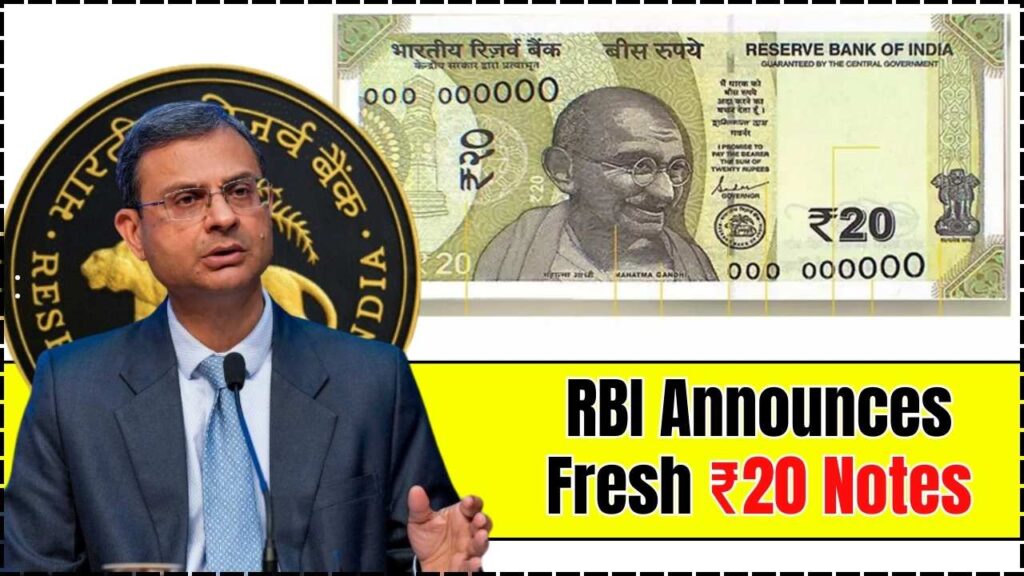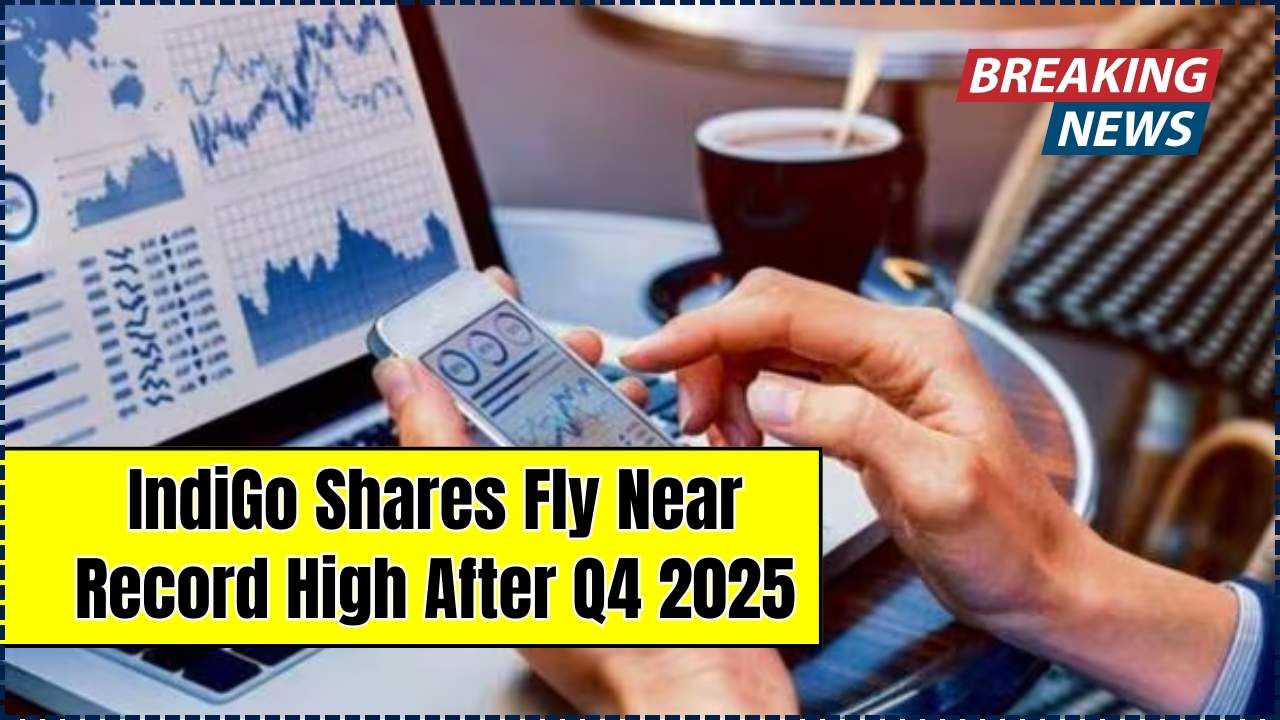RBI Announces Fresh ₹20 Notes: The Reserve Bank of India (RBI) has officially unveiled the introduction of new ₹20 denomination banknotes under the Mahatma Gandhi (New) Series. This issuance isn’t just routine printing—it carries important updates that reflect a recent change in the RBI’s leadership. These new notes will bear the signature of the current RBI Governor, Sanjay Malhotra, who assumed office in December 2024. Though the design and technical features remain consistent with existing ₹20 notes, the announcement has drawn considerable attention from the public and financial experts alike, prompting clarification on what exactly is new, and what is staying the same.

In this article, we dive deep into why these new ₹20 notes are being introduced, how they compare with the existing ones, and what this means for everyday users and financial professionals. We’ll also provide a detailed look at the note’s features, share expert guidance on spotting authentic notes, and answer some of the most frequently asked questions. Whether you’re a curious consumer, a retailer, a banking professional, or someone who handles cash regularly, this guide will help you stay informed and updated.
RBI Announces Fresh ₹20 Notes
| Feature | Details |
|---|---|
| Denomination | ₹20 |
| Series | Mahatma Gandhi (New) Series |
| Governor’s Signature | Sanjay Malhotra |
| Dimensions | 63 mm x 129 mm |
| Base Colour | Greenish Yellow |
| Reverse Motif | Ellora Caves (UNESCO World Heritage Site) |
| Security Features | Watermark, micro-lettering, latent image, optically variable ink, color-shifting thread, and more |
| Design Change | None – Only signature updated |
| Legal Tender Status | Both old and new ₹20 notes are valid |
| Official Source | RBI Official Website |
The RBI’s issuance of new ₹20 notes is a routine administrative update, reflecting the appointment of Governor Sanjay Malhotra. There is no need for public alarm or note exchange. The notes retain the same design, color, dimensions, and security elements introduced in 2019, ensuring consistency and trust.
As a user, being informed helps you navigate rumors and misinformation with confidence. Whether you’re handling cash daily or occasionally, recognizing key features of genuine notes is vital for safeguarding your finances.
Stay updated through official RBI communication and help others understand the importance of secure and transparent currency practices in India.
Why Is the RBI Issuing New ₹20 Notes?
Currency notes in India bear the signature of the serving Governor of the Reserve Bank of India, a tradition maintained for legal and administrative transparency. Whenever a new Governor is appointed, the RBI begins issuing fresh currency with the new signature. This practice ensures that all currency reflects the authority of the current central bank leadership.
The new ₹20 notes featuring Governor Sanjay Malhotra’s signature mark this transition. Importantly, there is no change in the actual design, color, dimensions, or security features of the note. This move is part of the RBI’s ongoing effort to maintain uniformity in legal tender and does not signify any withdrawal or demonetization process. The existing ₹20 notes, including those bearing the signatures of previous governors, remain completely valid.
For consumers, businesses, and banking institutions, this update is primarily administrative. However, it’s important to understand how it fits into the larger framework of currency management in India.
Exploring the Design: Features of the New ₹20 Note
The ₹20 denomination currently in circulation belongs to the Mahatma Gandhi (New) Series, first introduced in 2019. The new notes continue this legacy with precise, high-security printing technology and design elements that reflect India’s heritage and modern printing techniques.
Obverse (Front Side) Features:
- Portrait of Mahatma Gandhi prominently placed at the center
- Micro-lettering with ‘₹20’ and ‘RBI’
- Color-shifting security thread with inscriptions ‘RBI’ and ‘भारत’ visible upon tilting
- Ashoka Pillar emblem on the right side of the note
- Numerals printed in Devanagari script to promote linguistic inclusivity
Reverse (Back Side) Features:
- Ellora Caves motif, showcasing India’s cultural richness and architectural excellence
- Swachh Bharat logo and slogan, reaffirming national cleanliness initiatives
- Year of printing clearly marked
Security Elements to Know:
- Watermark featuring Mahatma Gandhi and an electrotype ’20’
- See-through register where the number ’20’ becomes visible when held against light
- Intaglio or raised printing for tactile identification by the visually impaired
- Fluorescent and optically variable ink used in numerals and markings to prevent counterfeiting
To explore visuals and animations that explain these features, visit Paisa Bolta Hai, RBI’s official education portal on currency.
What RBI Announces Fresh ₹20 Notes Means for Different Stakeholders
For the General Public:
- You do not need to exchange your old ₹20 notes.
- All old notes are still valid and acceptable everywhere.
- Educate yourself and family members about basic note security features.
For Business Owners and Retailers:
- Accept both old and new notes at counters without hesitation.
- Train your staff to identify the new signature and verify other note features.
- Ensure that cash-counting or counterfeit-detection machines are updated, though the design is unchanged.
For Banking and Financial Institutions:
- Inform customers that this is not a demonetization drive.
- Help visually impaired clients with identification tools such as RBI’s MANI app.
- Be ready to circulate updated notes from RBI branches once available in volume.
For Collectors and Hobbyists:
- First-issue notes with a new governor’s signature may have long-term collectible value.
- Keep an eye out for unique serial numbers or pristine condition notes.
Busting Common Myths and Rumors
The launch of new notes often triggers misinformation online. Let’s address some of the most common misconceptions:
- Myth: Older ₹20 notes are no longer valid.
Fact: They remain legal tender without any expiration. - Myth: This is a precursor to currency withdrawal.
Fact: No withdrawal has been announced. This is a routine update. - Myth: New notes include additional secret security layers.
Fact: No new features have been added beyond those already in the 2019 design. - Myth: RBI is gradually replacing all older notes.
Fact: Only notes bearing the latest signature are being added to circulation—not replacing the old.
Staying informed through official channels like rbi.org.in and RBI’s verified social media handles is the best way to avoid falling for false information.
Spotting the Real Deal: Identifying Genuine ₹20 Notes
Understanding how to identify an authentic ₹20 note is crucial in today’s economy, where counterfeit risk persists. Here’s a quick checklist:
- Touch: Raised printing should be felt on Gandhi’s portrait and the RBI emblem.
- See-through: Hold up to the light to see the number ’20’ perfectly align in the see-through register.
- Tilt: Observe the thread color change and shifting hues in ink.
- UV Light Test: Under ultraviolet light, fluorescent elements like fibers and numerals glow.
- RBI MANI App: Available on iOS and Android, this mobile tool helps the visually impaired identify note denominations using voice prompts.
- Knowing these signs empowers users and strengthens trust in India’s monetary system.
FAQs On RBI Announces Fresh ₹20 Notes
Q1: Do I need to exchange my old ₹20 notes?
A: No. You can continue to use them as they are fully valid.
Q2: Are there any new security features in the new notes?
A: No. The features are exactly the same as the 2019 Mahatma Gandhi (New) Series ₹20 note.
Q3: Will these notes cause any issues in ATMs or vending machines?
A: Not at all. The design hasn’t changed, so machine readability remains unaffected.
Q4: Is this related to demonetization?
A: Absolutely not. This is a routine update and does not indicate any such economic policy.
Q5: Can tourists and NRIs use the new notes?
A: Yes, within India. Use outside India is subject to local currency laws.
Q6: Will RBI replace all old ₹20 notes soon?
A: No. Both old and new notes will circulate simultaneously without any withdrawal plan.






